Click here to learn more about the How to Identify article series.
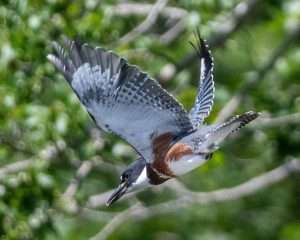
Name: Belted Kingfisher (Megaceryle alcyon)
Range and typical habitat(s): Widespread across much of North America except for Arctic areas, all through Central America, and the northern coastline of South America; occasional vagrants in Greenland, Iceland, British Isles, and elsewhere. Commonly found along both fresh and salt water, often seen perching in trees or on other structures while they watch for potential food in the water.
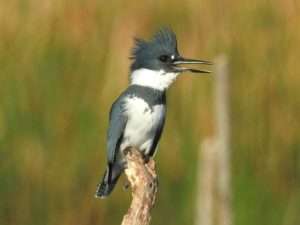
Distinguishing physical characteristics (size, colors, overall shapes, detail shapes): Belted kingfishers are around a foot long; the head with its long, spear-shaped bill, is rather large in proportion to the rest of the body, especially when the crest of feathers on the back of the head is raised. The wingspan is generally about 18-23 inches across.
Adult belted kingfishers are a dusty grayish blue on the head, back and wings, and a blue band across the breast. The neck has a wide ring of white around it, and the belly and other underparts are white as well. Look for a small patch of white in front of each eye. Adult females additionally have a rust-colored band across the belly; this is the easiest way to tell the difference between the sexes. Immature birds of both sexes have similar blue and white markings, except both have a rust belly band with white flecks, and the breast stripe is rust instead of blue.

The primary wing feathers of both sexes are white with black tips underneath, and black with a wide white band on top; the secondaries have incomplete black stripes underneath, and are back and blue with white spots on top; and the tertiaries and coverts are blue on top and white underneath. The tail feathers are blue with white stripes. The bill and feet are dark gray.
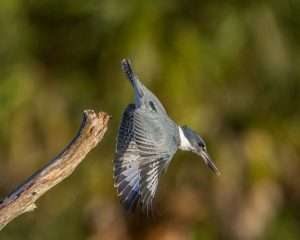
The belted kingfisher’s posture when perched is upright and alert. When diving into the water to catch prey, it holds its wings outspread, but then tucks them closer to its body just before it hits the water.
Behavior: Since these birds live primarily on fish, amphibians, and other aquatic prey, they’re most often observed waiting for food, or making a lighting-fast dive. However, they’ve also been known to eat mollusks, insects, small mammals, berries, and other terrestrial foods. In the nest, the young are able to digest the entire prey including bones and exoskeletons, but once older they regurgitate pellets of indigestible materials.
Belted kingfishers form monogamous pairs, and build their nests in cavities in dirt banks and cliffsides. These can be up to six feet deep, with an upward slope which helps to keep water out, to include during flooding. The female lays up to eight plain white eggs in each brood, and may have up to two broods a year. They hatch in a little over three weeks, and the young stay in the nest for almost a month before fledging.
If there’s a threat, belted kingfishers raise their crest of feathers and bounce their body up and down. They may also fly in an agitated manner while making loud rattling noises. Belted kingfishers often rattle while in flight, so keep your ears open near waterways.
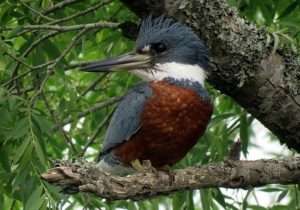
Other organisms it could be confused with and how to tell the difference: The ringed kingfisher (Megaceryle torquata) looks quite similar to the belted kingfisher, but is larger and heftier,
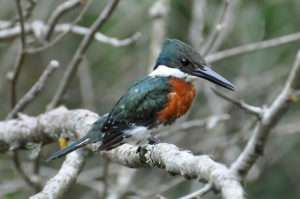
and both sexes have a copper-rust breast and belly. The green kingfisher is much smaller than the belted, and has a proportionately longer bill. It is metallic green where the belted is blue, and the male has a rust-copper breast while the female has a couple of green bands across the breast and no rust. Both of these lookalikes’ ranges barely reach North America, but overlap significantly with the belted range in Central and South America.
Anything else worth mentioning? Belted kingfishers are primarily found near natural waters, but may also be seen near artificial ponds with goldfish or other cultivated fish. And though they are most frequently sighted near water, they can be seen further inland from time to time.
Also, fun fact: it’s thought that both the belted kingfisher and its ringed cousin evolved from an African kingfisher species that found its way to the Americas millions of years ago.
Further reading:
All About Birds: Belted Kingfisher
Audubon Field Guide: Belted Kingfisher
American Bird Conservancy: Belted Kingfisher
Missouri Department of Conservation: Belted Kingfisher
